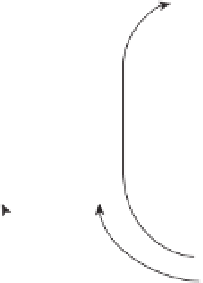Environmental Engineering Reference
In-Depth Information
tion and indicate the value of their use in conservation
and restoration science.
diversity lead to reduced fi tness and potential for adap-
tation, further reducing population size and the sus-
ceptibility of populations to effects of demographic
stochasticity, environmental variation and catastro-
phies, until extinction occurs (Frankham
et al
. 2005 ).
As far as the species level is concerned, ecological
restoration programmes aim at restoring habitat con-
ditions and/or
reintroducing
or
reinforcing
popula-
tions, thereby enhancing population size and
promoting greater connectivity among populations
(Montalvo
et al
. 1997 ; McKay
et al
. 2005 ). In this
section we consider population ecological and genetic
processes that are relevant in the context of ecological
restoration. Restricted gene fl ow affects the perform-
ance of populations in various ways. On the one hand,
it facilitates the process of local adaptation (section
7.2.1). On the other hand, it results in increased
inbreeding and associated inbreeding depression
within populations (section 7.2.2) and restricts the
opportunities to restore genetic variation that is becom-
ing depleted by random genetic drift (section 7.2.3);
the strength and impact of these genetic processes
stongly depend on population size. Finally we will
7.2
LOCAL POPULATIONS
Destruction and fragmentation of habitat lead to a
reduction in the population sizes of resident species, as
well as increased isolation among populations, result-
ing in reduced migration and
gene fl ow
, that is, the
movement of alleles between populations by migra-
tion, or transport of pollen and seeds. Reductions in
population size are often the start of a self-reinforced
negative spiral towards extinction that is known as the
extinction vortex
(Figure 7.1). Small, fragmented and
isolated populations become inbred because of the
higher proportion of matings that occur between rela-
tives, often leading to lower ofspring fi tness (
inbreeding
depression
). Such populations are also more prone to a
loss of genetic diversity because rare alleles are more
easily lost from small than from large populations as a
result of
random genetic drift
, as explained in section
7.2.3. The increased inbreeding and loss of genetic
Habitat loss
Small population
size
Low habitat
quality
Population
isolation
Genetic drift;
inbreeding
Low tolerance to
environmental/
demographic
stochasticity
Extinction
Low genetic
variation
Low itness
Low adaptive
potential
Figure 7.1
The extinction vortex. Habitat destruction leads to low quality of remaining habitat, isolation between remaining
populations and small population size (grey bar). Reduction of population size leads to a progressive increase in inbreeding
and genetic drift, loss of genetic variation and reduced fi tness, further decreasing population size until extinction. Reduced
population size also increases susceptibility to effects of environmental and demographic stochasticity and catastrophies,
further enhancing extinction risk. Other effects of habitat destruction (increased isolation and low quality of remaining
habitat) enhance the spiral to extinction through their negative effects on genetic variation and fi tness. Ecological restoration
aims to counteract these effects. (Modifi ed from Frankham
et al
. 2005 .)










